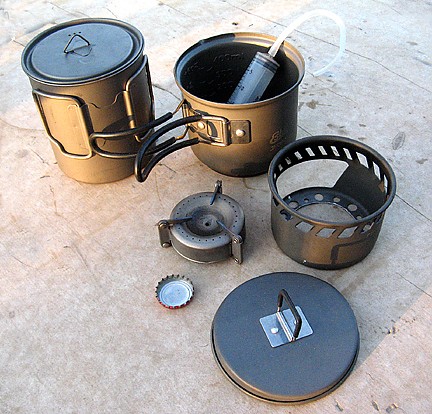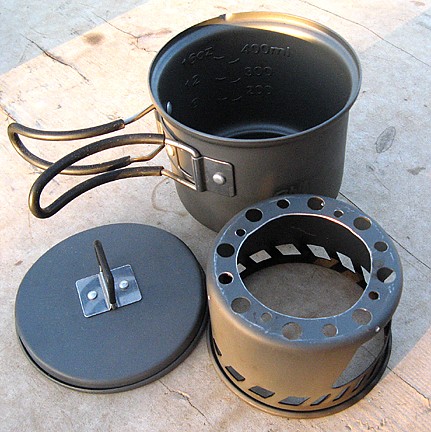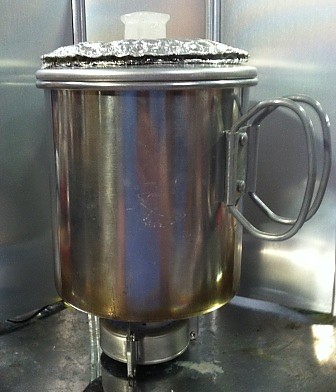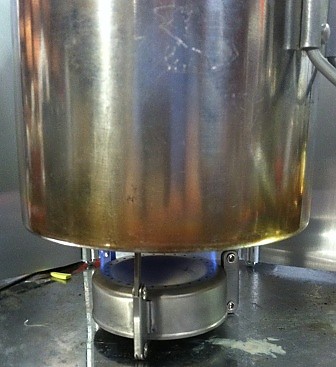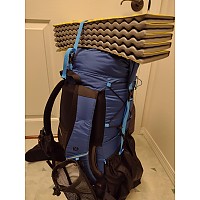Vargo Triad Alcohol Stove
The Triad Alcohol Stove has been discontinued. It was replaced by the Vargo Triad Multi-Fuel Stove for Fall 2017.
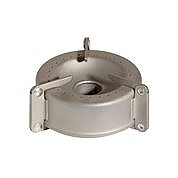
Once mastered it is a truly amazing device. Learning curve ahead if you have no experience with ethanol powered stoves. They are not for everyone!
Pros
- Weight
- Size
- Materials
- Compactness
- Ease of use
- Durability
- Clever design
- Fun to work with
- Awesome show piece for newbies
Cons
- Ethanol fuel can be challenging to master
- Fuel can be difficult to find at times
 Amazing stove design in that for about 1 ounce of weight and the size of a silver dollar, you can boil water quickly to make a meal or for other uses on a very small amount of fuel. This is the most efficient stove I have ever tested.
Amazing stove design in that for about 1 ounce of weight and the size of a silver dollar, you can boil water quickly to make a meal or for other uses on a very small amount of fuel. This is the most efficient stove I have ever tested.
CAUTION: Alcohol stoves require a degree of attention, focus, and learning curve that are unique to the fuel. Mastery of these determines your success. It is not a stove that everyone can use.
Example, ethanol has more BTUs per volume than gasoline! Try lighting a fire with gasoline and you get an explosion, very dangerous. Not so with ethanol, it has a relatively high temperature for going to a vapor and is most often assisted with a primer, which is a heating source that lifts the temp. to an ignition point which makes it a relatively safe fuel to pack around, does not blow up, but is very hot when it gets going.
Don't even try to work one of these without a wind screen. They are essential to success. Takes some practice to get it right, but well worth the effort once accomplished.
I read where others have difficulty with the stove due to the nature of the fuel and it is not the stove's fault in most instances. Learning how to handle the fuel correctly and acknowledge its unique characteristics is the key to having a fun relationship with this stove.
Review update/background:
One day I was browsing the local REI store (Eastlake Village, Chula Vista, CA.) and was in the stove section when a conversation got going with several of the bored salespeople. First off I was informed that at least in California, don't know how pervasive this is for other parts of the US, that solid fuel stoves have been outlawed. Any stove that does not have a "throttle" or control valve is now verboten! How Orwellian is that? As a result all stoves that did not comply were on deep discount, getting rid of them at cost.
Amongst these was an Esbit cookset #CS585HA. I am not an Esbit fan, but this cookset had some intriguing attributes that had the potential to be put to good use with that little gem, the Triad ethanol fuel stove. As you view in the images below, the bottom was cut out of the burner section where the tablet would rest so that the Triad flame could come through. Also the holes in the perimeter were indexed, three of them, so as to quickly and accurately locate the Triad pot support levers. When attached, they hold well and do not slip out of position, locked in. With this arrangement, it is possible to use the nesting Esbit pot or any other container above the alcohol flame with ease.
My kit consists of the following components: Triad ethanol fuel stove, modified Esbit cook set, Toaks 750 ml Ti pot, one bottle cap, one 20 ml syringe with attached, 6" x 1/8" silicone hose, Solo Stove wind screen, and 26 oz. fuel bottle.
Why the Toaks pot other than the obvious? Extinguishing an ethanol flame without adventures of the worst kind is desirable. The best way to do so is to smoother the flame, deprive it of oxygen. All other methods I have tried do not work well and are dangerous in my opinion. The 750ml Toaks pot fits purrrrfectly over the Esbit burner base and instantly extinguishes the hot flame. Any pot large enough can accomplish the same feat.
The syringe is the surest way I have found to not overfill the stove. Overfilling it results in a rapidly blooming fireball that will give an adrenalin rush! Best to be avoided than to deal with it! 30 ml is equal to 1 ounce of ethanol which is all the stove can hold safely. If the fuel puddles at the hole at the bottom of the stove top, it is too full and it will flare.
Knowing how much fuel is in the stove is important so that one can be certain of a complete burn to accomplish the task. It is dangerous to try to fill a hot alcohol stove. If essential to do so, cool it first. The syringe does not weigh much and sure takes the guessing out of the equation. If you know the stove and how much fuel it contains, you can figure getting through the burn without having to refuel it. Once smothered and extinguished, any remaining fuel can be returned to the fuel bottle.
The bottle cap is for priming the stove. It weighs nothing, hides anywhere, and is the least complex or costly means to get the stove up to vapor temperature. Simply place a few drops of alcohol into the cap, light it under the stove, and you're good to go. Soon the main burner will be spouting those lovely, little blue, hot flames. They are fun to watch.
I am currently using a thin wall stainless steel, 26 fl.oz. fuel bottle. Smaller, lighter fuel containers of choice depending upon number of anticipated burns and a little back up, JIC, can obviously be carried. Plastic containers should be avoided unless it is known that the ethanol will not dissolve it. Ethanol is very aggressive on most all plastics.
About ethanol fuel. The optimum ethanol fuel is pure alcohol, that is 95%, contains 5% H2O that is virtually impossible to remove under normal distillation processes. E95 is 95% ethanol motor fuel. I do not know if it can be used in the stove, but guessing it could. My understanding is that it does not contain any gasoline as does E85 and other blends. 95% - 200 proof ethanol is illegal in most states in the U.S. It is most likely found, if available, under the "Everclear" brand name.
Otherwise, denatured alcohol is what is commonly available, but can be hard to find depending upon one's location. Denatured alcohol is in fact ethanol, booze, that has been spiked with a poison so that it is not potable, cannot be ingested whereas the 95% can be. Denatured alcohol being a lower proof, does not burn as hot as the pure ethanol, but will do the job well.
I have not tested burn times with it as 95% is readily available in my location. Also as a side note, it is not difficult to distill your own ethanol with a simple still, sugar, and yeast! With these you can have an endless supply of stove fuel. The Joy of Home Distilling by Rick Morris is the go-to instruction manual for this technology.
The Esbit cook kit is nicely designed, anodized aluminum with two stuff bags, one for the entire kit and another one for the internally contained burner base into which I also contain the Triad stove, bottle cap and igniter. Nice package. The Toaks pot can be easily filled with other goods, socks, gloves, towel, etc. to become invisible in the pack.
I am shocked at the price for a 600 to 800 ml titanium pot these days—$100! Good grief how is that possible?
The numbers:
- Esbit cook set with two stuff bags: 7 oz / 205 gr
- Toaks 750 ml Ti pot with stuff bag: 3.7 oz / 105 gr
- Triad stove: 1.1 oz / 32 gr
- Syringe: 0.6 oz / 17 gr
- Solo Stove wind screen: 7.6 oz / 215 gr
- Total kit: 20 oz / 574 gr
- Fuel bottle; stainless steel, holds 26 fl. oz / 784 gr, sufficient for 26, 1 oz.-burns, which is equal to 263 minutes of burn time = 4.4 hours
- Test environment: 3,000 ft. altitude; 74 degree F H2O temp; ambient air: 68 degrees F
- Esbit pot 400 ml: 16 oz. to boil: 8 minutes
- Toaks 750 ml pot to boil: 10 minutes (1 oz. of fuel)
- Total burn for 1 oz. of fuel: 10:06 minutes
Source: Have had it so long, don't recall that detail, sorry.
This stove does exactly what it is made to do. I have built a good quantity of soda stoves, but they all burned up over time.
Pros
- Light weight
- Durability
- No internal parts to wear out
Cons
- Past production issues
- Bad reviews on old models
I have tried a bunch of homemade stoves that worked great, but they all burned up or got damaged over time. I got tired of making stoves. I have had my eye on this model for years, but stayed away due to reviews of bad build quality and poor performance.
Over time, I picked up a Vargo Decagon and had great luck with it after a little practice. My only complaint was it being too large to nest in most of my pots. I was sold on the titanium stove concept though.
This week I ended up in Calgary for work and found one I could inspect before purchase. I noticed a difference right away. The legs and pot stand now stand straight vertically and don't lean out, giving you a better flame distance. Much different than the photo above. The build quality on both units in the store was great so I purchased one.
Tonight I gave it a trial run with 2 cups of water and was very pleased with the performance. I have noted with every alcohol stove I have used, that the first burn is the weakest with improvement happening with the next burn. If this is still true, this is going to be a greater stove than I imagined. The key to Vargo performance is all in the wind screen. The heat reflected back to the stove is vital for function.
I also believe poor build quality is a thing of the past for these stoves.
6/23/15 Update:
I have done a bit more testing with this stove. This test was run indoors in my shop at approximately 40 degrees with room temperature water.
I was curious to know how this burner would handle 32oz of water.
I filled an Open Country coffee pot with 32oz of water, filled the stove (1.25oz of denatured Alcohol) lit the stove, set the pot on the stove. I got a rolling boil in 15 minutes, 34 seconds.
Two benefits of this stove are:
- You take advantage of any heat while the stove is priming.
- The flame pattern is nearly straight up, so it works well with narrow pots.
After the boil, I decided to let the stove keep running until it burned out. It finally stopped at 23:53. A total of 8:19 run time after boil. I consider this quite impressive.
These are ideal conditions, but with proper wind screening, I think these numbers should be close to accurate.
Source: bought it new
Price Paid: $28 Canadian
Lightweight and durable, having its own folding legs and pot stand "horns" built in. Fire is good and stable. Boiling time +- as promised yet fire is hard to control and extinguish.
Lighting: no primer or pre- heet need. feeling hole very small. u have to feel it all to light.
all by all, i think it's a good product that worth it's money.
Pros
- Lightweight and relatively durable
- Has its own folding legs and pot stand build in
- Burns well and study with quiet a strong flame
Cons
- Wind protection is a must
- A bit hard to fill and light
- Needs a bit of more gas, hard to extinguish
- Need a small box or hard case to protect from damage in pack
Lightweight and durable, this light alcohol stove is quiet a good product aiming for light hikers. Considering it against an ultralight gas stove + canister, u save about 300 grams. Very nice.
Having its own folding legs and pot stand "horns" build in eliminates the need for a separate pot stand. (for the weight enthusiastics: consider it against your home made can stove+ pot holder. in my case, weight difference if about +13 grams).
So, for total of 28 grams, it's very nice for thruhikers or light hiker.
Lighting: this stove have no need for primer or pre- heet . yet feeling hole is very small, obligating a small and steady amount from a standard ultralight pouring bottle (not supplied). u have to feel it all to light up, so u "waist" some fuel - all together, i used round 45 mil per use.
Boiling time is around 6 minuets for 2 cups, as promised (i Measured 5/5 min. for 500 ML of water, outside with a bit if of wind, round 22 Celsius , full wind protection in a covered pot).
Fire is hard to control and if fuel left in after finished your cooking it will not always blow when u try to extinguish it.
Burn & simmering: fire is good and stable, yet as all alcohol stoves it needs very good wind protector and is hard to simmer on. in this model, home- made simmering rings were not so good and i found it best to improvise arrangement that leveled the pot from flame while simmering. have dune rise and soup and Dried stuff, it went ok but u have to know your way in basic trail cooking. i tend to use a 120 - grams 0.9L light steel pot with a bit thick bottom, willing to pay the "weight penalty" for some better heat spreading that will not burn the food easily. not sure if a beer can pot will do the same for it's thin bottom.
Making your own ultralight can stove is not hard, yet eventually u need some export skills to make them really good, reliable and can be counted on the trail. after spending round 50 working hours and many model tests, i have decided to buy the vargo. should have dune it the first place and save all this bother...
All by all, I think it's a good product that worth its money.
Source: bought it new
Price Paid: 26$
$30 for a compact titanium (durable) alcohol stove (lightweight system) with folding leg anchors and pot stand! I have compared this to a lot of cooking systems and this is my favorite.
Pros
- Titanium (very durable)
- Folding legs and stand
- No internal moving parts (simple and reliable)
- Compact
- Lightweight system (weight of stove, fuel, and container)
Cons
- It is still alcohol so you need a windshield
- It is still alcohol so you can't refill the stove while it is hot
- It is still alcohol so you have to prime it into a vapor
- Some pot sizes might not work with the stand
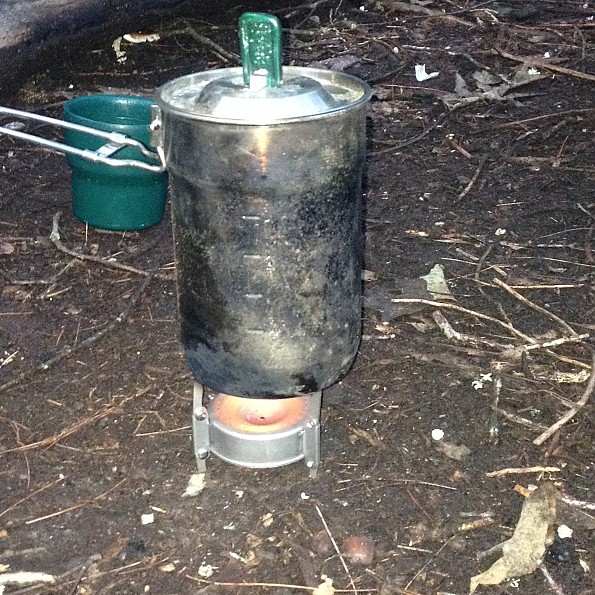
I am a mechanical engineer and I have literally made hundreds of soda can stoves trying to perfect the design for durability, size, and fuel usage. I love them, but this is my "go-to" stove while hiking.
I love to have three legs that I can anchor into the soil and I love having the integrated pot stand. I have had a water pot tip over on a soda can stove once and puddles of burning alcohol on the ground are not fun. Titanium is far more durable than aluminum. This stove fits nicely inside my mess kit with the windscreen (a must-have for ALL alcohol stoves or you will use a lot of fuel).
Although, I feel that this design would benefit from an internal aluminum "priming" pan (which I can't add myself) because of how large the fuel reservoir is, I either prime it with a bottle cap or a lighter just under it. For $30, this is an amazing piece of gear.
Source: bought it new
Price Paid: $30
Super lightweight, effective at boiling water.
Pros
- Ultralight
- Sturdy
- Stable
- Easy to use
- Fuel is accessible
Cons
- Can be a little finicky until you figure it out
- Can't simmer
This stove is made well, and weighs almost nothing. I use it with my GSI Minimalist setup and it works great. It's sensitive to wind like all alcohol stoves so a wind screen is a must. The stove is super stable if you plant the legs into the ground.
It can be a little finicky until you figure it out. If you over fill it it will usually boil over and surge flaming alcohol over the sides instead of the jets lighting. Priming the stove helps but isn't necessary. It will usually flare up on its own.
I find that about a half inch gap all the way around the wind screen is best, it keeps the heat under the pot more and leads to a faster bloom and boil times. It takes about twice as long to boil as my MSR Pocket Rocket, but also gets rid of the need to carry a canister, and weighs like 1/10th as much.
If you're using your stove to simply boil water for dried foods like Mountain House this is a great option, but keep in mind it is more work to get going than a canister stove. I can get this stove, my wind screen, a lighter, the little potholder in my GSI Minimalist, a GSI Telescoping Foon and a small 4oz Listerine bottle for fuel inside the GSI minimalist pot with room to spare, super compact and lightweight setup.
Source: bought it new
Price Paid: $25
Judging from the negative reviews, some people should stick to butane stoves. I have used the Triad for years in snow, rain and wind — and it has replaced all my many other stoves.
You have to use common sense in two respects: First the Triad burns methanol vapor, not liquid methanol. The stove has to be heated to the boiling point of methanol to give maximum heat. Rather than waste fuel with the puddle on top method, I use a tiny bottle cap under the stove to prime it. Depending on the weather and temperature, about 5 drops of burning methanol in the cap is enough to begin to vaporize the methanol in the stove.
Secondly, you HAVE TO USE A WINDBREAK! Alcohol flames are soft and low pressure and wind blows the heat away from the pot more than with other stoves. I use a piece of aluminum flashing that stores tight inside my MSR pot and takes no space at all. The handles of my pot get too hot to touch, but I boil 12 ounces of water in minutes with a half filled stove. I
just began using an eyedropper to fill my Triad — 12- 15 ml. of methanol is more than enough to boil water for a meal and a cup of coffee. Then I let the rest burn out. I get three meals and three cups of coffee and have fuel left over in a two ounce fuel bottle.
I pack two ounces of methanol per day. The Triad is the smallest, lightest, most reliable and efficient stove I have seen.
Come on people, isopropyl is NOT stove fuel! Use ONLY PURE methanol without the auto fuel line additives. And no, I have no interest in Vargo. I just enjoy warm food when I travel.
Price Paid: I forget, about $30 I think.
The Vargo Triad titanium stove is a very lightweight, durable stove. It sells for around $30 which depending on how much you'll use it plays a factor as well.
Pros
- Weight
- Efficiency
- Durable
Cons
- Priming
- Fuel capacity
- Very vulnerable to wind
This stove is a neat, little compact stove I came across while looking into alcohol stoves. The stove is lightweight, being made of titanium, yet very durable. It weighs a mere ounce and you hardly know it's in your pack or even your pocket!
The stove includes 6 retractable legs (3 on top 3 on bottom.) They recommend that the bottom three be carefully pressed into the soil to keep the stove firm while cooking. The top 3 legs act as a pot stand. Not once of the many times I've used this stove has it collapsed on me.
This stove is fueled by denatured alcohol or HEET in the yellow bottle which is what I use. The stove is ignited by you striking your flint and landing in the alcohol concave. Also when fueling it you must over fill it a little bit for it to prime then causing the flames to come out the jets. Burn time with a full stove is around 20 minutes, but it has burned longer or shorter in certain conditions. The stove boils 2 cups of water in 5-7 minutes (again varies on wind and temps).
The only drawbacks of this stove are its disability to function to its fullest in windy conditions and at times I wish it had more fuel capacity. Priming isn't a big deal unless you accept the risk that you need to watch what your doing. NEVER pour more alcohol on a just extinguished stove. I have done it and received a little zing of flames back up my arm.
I hope I convinced you to buy one as they are great products! For more info on Vargo visit Vargooutdoors.com
Source: bought it new
Price Paid: $29.99
Does exactly what it says. One of these reviewers does not know SQUAT on alcohol stoves. FYI, hold a match or lighter under stove for a few seconds and boom, stove is on, no 2-3 minute priming time, that goes for pepsi cans too. Can be done in seconds and saves you a lot of fuel. As light or lighter then a pepsi stove.
I only know hikers that take it seriously, it's all about weight and function. This nails it. Ultra light and functions.
Price Paid: $30
It works in the tropics where I backpack. Best for boiling water, but one has to be extra careful in putting the pot on the pot support or it will tip over.
Pros
- Ultralight
- Fuel efficient
- You can recover unused fuel
Cons
- A challenge to put pot on the pot support
- Putting fuel on top takes time
- One needs a reliable windscreen
I love this stove. But it can only be appreciated by ultralight hikers who bring dehydrated and other add-water only types of food. Essentially, I use this for boiling water.
If one prepares food the old way, with lots of stirring and turning, better get something else. The pot, balanced on the three pot supports, can easily tip over if one isn't careful. This is the most frustrating part of it. But because of its weight, it's my go-to stove.
The negatives are things that I have come to accept in return for an ultralight gear. But seriously, I'm now looking at the Decagon; pot can be more stable in it—who knows?
Source: bought it new
Price Paid: Around 1,600 Philippine pesos
I have never used this type of stove before. Although I was infatuated with the ideal of ultralite movement, this little item goes beyond its label as an AT type, chop your toothbrush in half and sleep in a bivy sack, device. Alcohol stoves are very efficient, both in terms of fuel savings and heat generated from that brilliant blue flame.
This little puppy boiled 16oz of water in 4 minutes flat, after a 1 minute prep at 450ft elev. That's enough water for a Mountain House dinner. Not to mention it kept burning for another 10 minutes on a spits worth of alchy.
Beyond that, all you really need is a nice little squirt bottle and some foil for a wind screen, and you just saved ~2lbs from losing the white gas cooker.
Plus:
*The legs can be used as a spout to pour the leftover alchy back into your bottle.
*Cools down fast and titanium is corrosion resistant.
*Can use fuel tabs if turned upside down.
*Denatured Alcohol was 5 bux for a quart at Lowes in the paint section. This will probably last me 2 years. I typically go through 2+ Primus/MSR white gas containers in a year at around 6 bux each.
Minus:
*Made in China, err, I mean it wasn't quite level out of the box so I had to finalize the QA process to make it just right.
Price Paid: 30 bux
Enjoy Triad 2.0, but use the old one to store weed.
Pros
- Very good container for marijuana
- Light
- Easy to throw
- Slightly cheaper than wadding up 35 one-dollar bills and burning them instead
Cons
- See above
Vargo knows they missed by a mile on the old, flat-top version one of this stove.
Pos reviewers: It's not about your mad stove skills. The arms were too wide and the top was too flat. How hard would it have been to make the top ever so slightly concave to hold an economical puddle of primer fuel? Oh, wait. They did that on the redesign. Or to take the curve off the support arm surface, and move the arms ever so closer? Oh, wait. They did that on the re-design.
Seriously: Congratulations to all who made this POS work out. But repeat after me: Vargo redesigned the Triad because the first generation was seriously flawed. Enjoy Triad 2.0, but use the other one to store weed.
Source: bought it new

Excellent durability. I am confident you could step on this stove (legs folded) and not crush it.
This stove is extremely lightweight at less than an ounce.
I have only used this stove in fair weather and spring/ summer conditions. Coldest temp operated in is 50°F.
The burn time is ample to boil at least a quart of water. The stove seems to be more efficient with my Titanium pots than when used with my aluminum pots.
I also like the stability. My Snow Peak solo set fits nicely on the supports. I have had no issues with stability. I can also pack my stove in the small pot.
An 8 oz. bottle of alcohol will easily get me through three nights in fair weather with reasonable care in fuel consumption.
Windscreen is a MUST.
Source: bought it new
Price Paid: $29.95
Love it... Very light and simple. I have used it down to 30 degrees with no problems. Must use some kind of wind screen or the heat output suffers greatly and/or the flame gets blown out.
I won't say its a good water "boiler" but it will produce steam and bubbles when heating 2 cups of water with one stove fill up. That is enough for freeze died dinner or tea etc.
I use a little flip bottle full of alcohol holds about 3 fill ups. Together with stove weighs 3 ounces! So figure about 3 ounces per day. One weekend is about 6 ounces of weight.
Price Paid: $29
Works great, needs windshield, hold flame underneath to light stove with less alcohol. Love it. Light as a feather, has legs and stand. NEEDS WINDSHIELD!
Pop cans are great too, have one, love the supports on either side of this.
Price Paid: $25
I bought this stove based on how it looks. Compared to my friends stove (Zelph's Starlyte?) the Triad is a joke. The reader who referred to the BPL reviews was right. I wish I had read those before I wasted my money on this thing. Buyer beware-suggest you read the BPL alcohol stove/reader reviews first.
Price Paid: $29
Anyone that gives this stove a positive review either works for the company or has serious mental problems. PLEASE read the "Reader Reviews" for Alcohol Stoves at BPL before you waste your $$$ (like me) on this stove. This stove does look cool but you will be 10 times happier with a homemade pop can type stove.
Price Paid: $29
Your Review
You May Like
Specs
| Price |
Historic Range: $19.83-$29.99 Reviewers Paid: $25.00-$30.00 |












